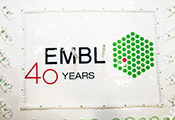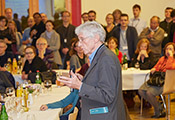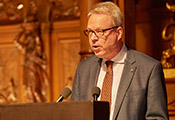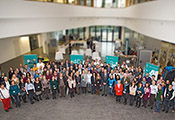27 November 2024
“Nowadays, 95% of all protein structures are solved using synchrotron radiation – X-ray protein crystallography, alongside recombinant DNA technology, has become one of the twin pillars of molecular biology,” said Holmes, who was a central figure in mobilising support for EMBL Hamburg. The rest, as they say, is history, and in his pre-dinner speech, Holmes gave guests a unique personal account of the journey he and his colleagues ventured on in those early days – a talk peppered with hilarious anecdotes remembered by his then student Gerd Rosenbaum.
Throughout the symposium participants explored the past, present and future of crystallography in biology through stories of science, structures and synchrotrons. Michael Rossmann from Purdue University, who gave the keynote lecture, recalled tales of scientific research spanning some six decades – beginning in Cambridge working under Nobel Prize winner Max Perutz and ending with his current pioneering studies on viruses. “We used to spend weeks punching buttons on a calculator to establish electron density maps,” he recalled, describing key moments that have lit the path of his research.
Instances that have defined EMBL Hamburg’s own history – from the development of small angle X-ray scattering, to the opening of PETRA III – provided rich discussion topics. “EMBL Hamburg began life in a small bunker, but we soon outgrew it – now look at us,” said Heinrich Stuhrmann, former head of outstation. “We have seen a fantastic evolution of data collection capacity,” said Keith Wilson, also a former head of the outstation. Meanwhile, alumnus Jules Hendrix gave a first hand account of the development of the first imaging detector, which has changed the way crystallography is done: “We convinced ourselves we could do 25 times better than using film – and we did!” he said.
The event, which included an extensive programme of topics ranging from user experiences, to science history, to research capacity building, also provided an opportunity to celebrate the outstation’s close collaboration and friendship with DESY, with the directorates of EMBL and the research centre renewing their partnership agreement and committing to another decade of successful collaboration. “There is a great synergy of complementary expertise on our campus, something that we have demonstrated very effectively in the past 40 years, and this will continue long into the future,” said Helmut Dosch, chair of the directorate of DESY.
A closing reception took place in the grand setting of Hamburg’s famous city hall, with science senator Dorothee Stapelfeldt joining Silke Schumacher, EMBL’s director of international relations, and Matthias Wilmanns, head of EMBL Hamburg, in marking the important bonds EMBL and the DESY campus continue to make with the city. “It is a very exciting time for the field of structural analysis in Hamburg – thanks to the close partnerships that we have formed, when we meet again in 10 years time we will be able to look back on a wealth of yet more incredible research,” added Matthias Wilmanns.
No birthday celebration would be complete without a good party, and festivities rounded off with good food, music, laughter, dancing, and chatter between colleagues and friends, past and present.
Written by Rosemary Wilson


Ken Holmes gives a pre-dinner speech to gathered colleagues, alumni and friends.

